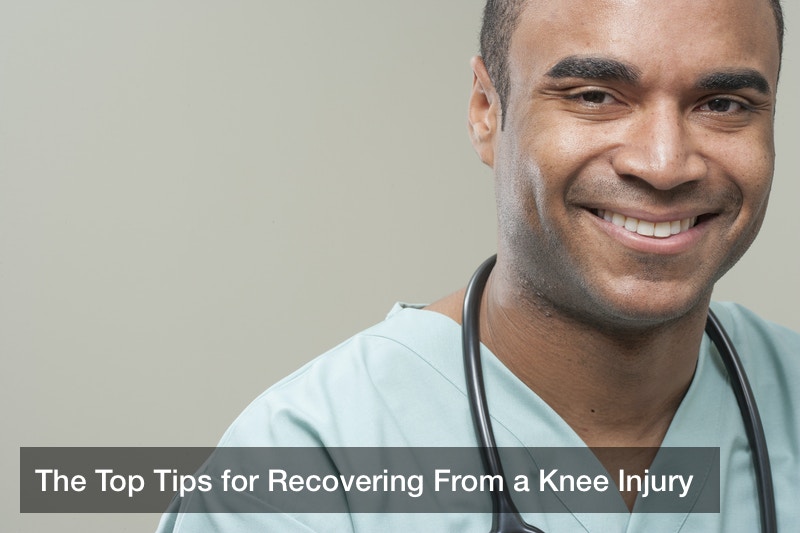
Seven million years of evolutional development has turned you into the modern-day human, the bipedal species you see in the mirror. (Looking good, by the way!) While walking on two legs has many perks (like being at the top of the food chain, for example), it also has its disadvantages from time to time — namely in the form of injuries to your knees.
Whether you play sports, have been in an accident, or are simply a clumsy human being, chances are that you’ve suffered some form of knee injury or another. Some injuries are more serious than others — while a knee brace and a few days of rest might resolve one person’s pain, another might require surgery to repair the damage done. No matter what the eventual outcome, treat your knees with the utmost care; you’ve only got two, after all!
Start With Some RICE
If you play sports then you have likely heard of the RICE method: Rest, Ice, Compression, Elevation. The steps are simple and relatively self-explanatory, but you don’t want to overdo any one of them. For example, too much icing could potentially cause more damage, etc. Follow the RICE method by the clock for the best results.
Rest. Time to hunker down and binge your favorite Netflix series — you need to rest that knee injury. Refrain from participating in any strenuous activities, even walking up and down the stairs; your muscles need a chance to rebuild.
Ice. Ice reduces swelling, which is exactly what your injury needs right now. Apply an ice pack to the injured area for ten to 20 minutes; it is recommended that you do this three or more times a day. Once after 48 to 72 hours, check to see if the swelling has gone down. If it has, follow the same ten to 20-minute cycle with a heating pad or heating oil. Note that you should never apply hot or cold directly to the skin, so wrap compresses in a towel before applying.
Compression. Another way to decrease swelling to an injury is to compress it, which means wrapping it with some kind of bandage. You can find medical bandages such as ACE brand at any drug store, as well as knee braces to Velcro your injury into place. You should only need to wrap the injury for about 48 to 72 hours; anything longer than that should be approved by a doctor.
Remember that you should not wrap the injury so tightly that it prevents proper circulation, which can in turn cause more swelling. Loosen it if it’s uncomfortable or you start feeling weird symptoms such as:
- Increased swelling or pain on the injury
- Coolness
- Numbness or tingling (like the feeling when your leg falls asleep)
Elevation. While you’re chilling on the couch, don’t forget to prop your leg up to help with swelling and circulation. You can use pillows or blankets to prop it up, but try to make sure the injured area is above your heart.
Visit the Doctor

Regardless of how severe you think your injury is, a knee injury should never be downplayed. Failure to diagnose a more serious issue could lead to improper healing, which could in turn create a lifetime of knee pain or repeated issues. Cut all that off at the chase by seeing a medical professional as soon as you can.
Make an appointment with your general practitioner or, if you don’t think you can wait that long, visit an urgent care center near you. Usually, urgent care facilities are equipped with semi-advanced technology such as X-ray machines and blood labs, so you can expect to get same-day treatment.
If the injury is less serious, your doctor will probably recommend you do the above and continue following the RICE method. They might also prescribe you a muscle relaxer to help with pain and muscle spasms. If you happen to have a more serious injury, however, your doctor may refer you to a sports medicine specialist or perhaps even a surgeon to take care of it.
Understand Your Legal Options
If you were injured in your own home, likely there’s no legal compensation to be found; anybody can get hurt in their own home, right? If you were in public or at work, however, this scenario changes drastically. Improper or unsafe conditions that could have contributed to your injury could give you a potential lawsuit against the responsible parties.
If you think that you might have a case, it’s worth contacting a workers compensation lawyer to understand your legal rights. When you’re looking for an attorney to take on your case, look specifically for a law practice that specializes in worker’s compensation and on-the-job injuries. These professionals understand the laws and legalities in the field far better than a general defense attorney, which makes it worth your time and money to see what kind of options you have.
This is not to say that you should be overly litigious. Don’t try and get money out of someone for the sake of getting money; ask yourself if the parties you want to sue are truly at fault. Lawsuits can be potentially career-ending, and you don’t want to ruin somebody for all the wrong reasons.
Slow Down

In life, especially life in America, it’s easy to get caught up in the go, go, go lifestyle. We are fast-moving people with things to do and people to see. Between work, school, juggling a family, and keeping up with friends, life is busy. If you’re recovering from a knee injury, though, perhaps it’s better to slow down a tad.
If you’re clumsy (and don’t feel bad if you are; it happens to the best of us), take a minute to look ahead of you, chart your route, and avoid any potential hazards. Instead of dashing down the hardwood stairs in your socks, maybe put on a pair of slippers or walk while holding the handrail. Hurrying down the sidewalk in the pouring rain? Wear the correct footwear and watch your step.
Life is way too short to rush through it. If you can, try and turn your injury into a positive thing; yes, it hurts and it takes forever to heal, but on the bright side, you are no longer zooming through life on top speed. Slowing down is good for the klutzy individual, but it’s also good for the soul.
Take Whatever Physical Therapy Is Offered

Part of recovering from your injury might include a rehabilitation service of some kind. If this is offered to you by your doctor, don’t decide against going. Physical therapists are licensed and specially trained in their field to get you literally and figuratively on your feet again.
Rehabilitation facilities offer every kind of physical therapy you can imagine, and you learn exercises and techniques that will help you recover and regain muscle control. These are more than useful tools to recover from your current injury; they can also be applied in the future if you ever have another injury.
Physical therapy also needn’t end once your current injury has recovered. The beauty of physical therapy is that you can return to it down the line if you don’t feel like you’ve recovered, or have re-injured the area. Hang onto the number of your physical therapist in case you need them again down the line.
Do take advantage of your doctor’s physical therapy referral. You will thank yourself later when you realize how much better you feel afterward.
Don’t Jump Back In Too Soon

Look, we understand: Recovering from an injury is boring, especially if you’re an active person by nature. But you need to ensure that you’re fully, completely recovered before restarting all of your usual adventures.
Don’t assume that you know better than the doctor; continue to follow the doctor’s orders and take it slow. Instead of deciding to go for a three-mile jog the moment you feel better, try walking around the block. How do you feel after that? Give yourself a moment to actually feel how you feel before deciding you’re cured.
It’s important that adults exercise for at least 150 minutes (two and a half hours) every week to stay healthy, but after your recovery, think of ways to work out without needing to use your knees, or put very little strain on them. This can include:
- Swimming. Yup, you read that right! Regular swimming is a full-body workout and is actually fantastic physical therapy for a knee injury. As you regularly swim, the muscles surrounding your knee joints build up and start strengthening, allowing your knees to become stronger and less prone to further injury.
- Rowing. You get an awesome upper torso workout when you practice rowing (whether that’s on a machine at the gym or actually in a boat), so your heart and circulatory system are worked out without hurting your knees.
- Yoga. Some poses are more beneficial than others for knee pain specifically, so look into which can help your injury. Yoga is a millennia-old practice that helps with flexibility, your circulatory system, and your heart.
Remember, recovery is not a race. Being kind to yourself and taking it easy on your injury will help you to feel better faster, and to stay feeling good long-term.
Learn to Live With Chronic Pain
Eveb after physical therapy, surgery, and a long recovery time, the truth is that you might feel some residual pain after your injury. Some people feel arthritis in their joints, some people feel tightness, and still others feel stiffness. It varies from person to person, and if you happen to be living with chronic pain after your recovery, it’s important to learn to manage it.
Service dogs can be a wonderful addition to your family to not only help you with your emotional support and wellbeing, but they’re even better doggies than that: With special training, some even know how to fetch your medications. To see if you qualify, check out what is required for service animal registration. Remember that regular vet services and pet tracking services (microchipping) still apply when you take on a service dog, so ensure that you have room in your budget, home, and heart before taking one on.
Medicinal marijuana is another way to manage chronic pain. Though still federally illegal in the United States, the herb is finally making its way through the country for recreational and medicinal use. When used medicinally, marijuana can decrease symptoms of pain and swelling; help ease depression and anxiety; and stimulate the user’s appetite. If you want to make use of the herb without the psychoactive effects (the high), CBD gives you all of the positive side effects and none of the high. Rub CBD oil on your sore muscles, take it in tablet form, or smoke the flower.
Consider also medical massages. You might be pleasantly surprised to learn that some medical insurance companies accept bi-weekly or monthly massages as part of a wellness plan, so double-check with your insurance provider. While medical massages over the injury itself are beneficial to your knee, full-body massages are also fantastic for you:
- Stress is reduced. Seriously, with someone rubbing your sore muscles in a quie, darkened room, how could your stress levels not be reduced?
- A single massage is a wonderful enough thing, but long-term massages can also have long-term effects: Your circulation, lymphatic system, and muscle tension all improve over time. Isn’t that great news?
- Your joints are loosened and less stressed, allowing easier recovery from injuries in the future, as well as relief from current pain.
When you’ve suffered an injury, the recovery process is a long one. Knee injuries especially take time and extra care thanks to the essential role that your knees play in your body. Understand the best ways to deal with the pain, treat swelling, and how to manage pain in the days, month, and years that follow your injury. Remember, it’s okay to slow down and give yourself time to heal. The road to recovery has many different backstreets, but after you decide which route is best for you, your injury can become a thing of the past.



